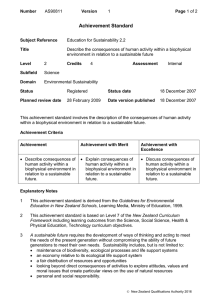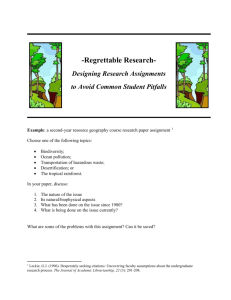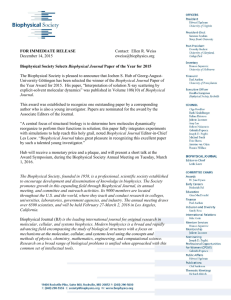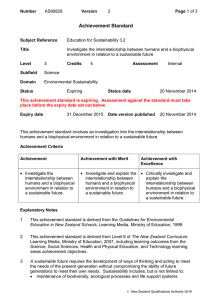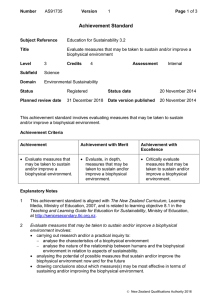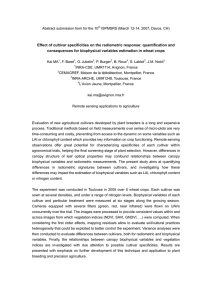Achievement Standard
advertisement
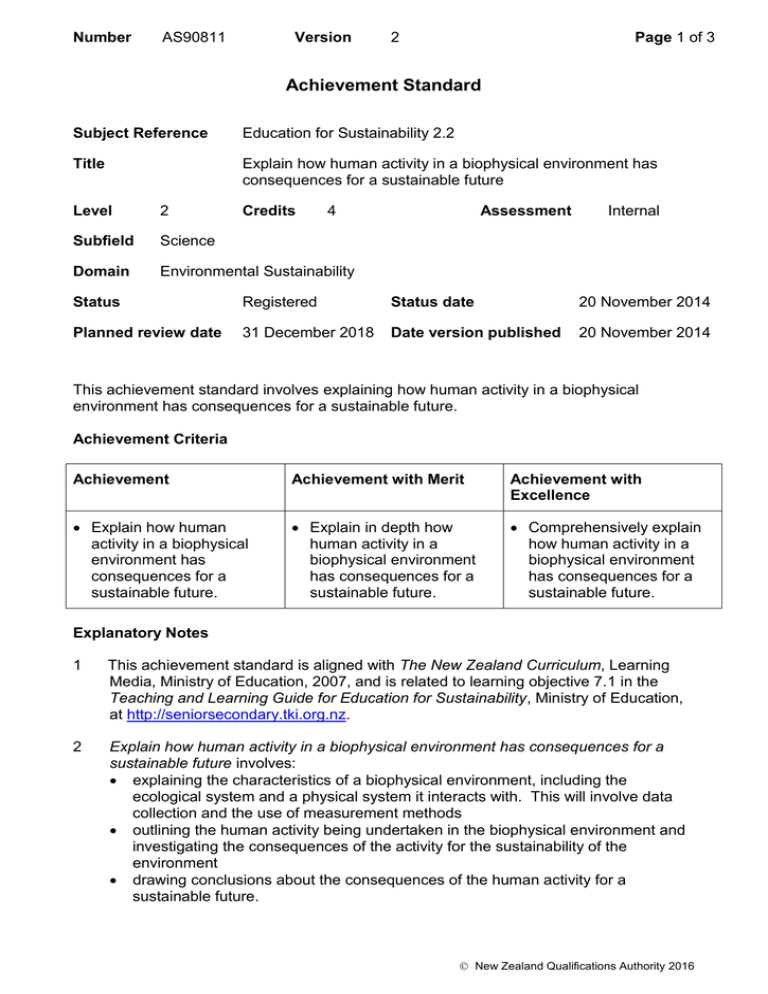
Number AS90811 Version 2 Page 1 of 3 Achievement Standard Subject Reference Education for Sustainability 2.2 Title Explain how human activity in a biophysical environment has consequences for a sustainable future Level 2 Credits 4 Subfield Science Domain Environmental Sustainability Assessment Internal Status Registered Status date 20 November 2014 Planned review date 31 December 2018 Date version published 20 November 2014 This achievement standard involves explaining how human activity in a biophysical environment has consequences for a sustainable future. Achievement Criteria Achievement Achievement with Merit Achievement with Excellence Explain how human activity in a biophysical environment has consequences for a sustainable future. Explain in depth how human activity in a biophysical environment has consequences for a sustainable future. Comprehensively explain how human activity in a biophysical environment has consequences for a sustainable future. Explanatory Notes 1 This achievement standard is aligned with The New Zealand Curriculum, Learning Media, Ministry of Education, 2007, and is related to learning objective 7.1 in the Teaching and Learning Guide for Education for Sustainability, Ministry of Education, at http://seniorsecondary.tki.org.nz. 2 Explain how human activity in a biophysical environment has consequences for a sustainable future involves: explaining the characteristics of a biophysical environment, including the ecological system and a physical system it interacts with. This will involve data collection and the use of measurement methods outlining the human activity being undertaken in the biophysical environment and investigating the consequences of the activity for the sustainability of the environment drawing conclusions about the consequences of the human activity for a sustainable future. New Zealand Qualifications Authority 2016 Number AS90811 Version 2 Page 2 of 3 Explain in-depth how human activity in a biophysical environment has consequences for a sustainable future involves: drawing informed conclusions about why human activity in a biophysical environment has consequences for a sustainable future. Conclusions are based on a clear, logical argument and supported by evidence. Comprehensively explain how human activity in a biophysical environment has consequences for a sustainable future involves: drawing insightful conclusions about the wider implications of how human activity in a biophysical environment has consequences for a sustainable future. The conclusions may include projections of future impacts and consideration of options for actions that show personal and social responsibility for a sustainable future. 3 A sustainable future requires the development of ways of thinking and acting to meet the needs of the present generation without compromising the ability of future generations (of all living things) to meet their own needs. In Aotearoa New Zealand, a sustainable future reflects, wherever possible, consideration of Māori concepts and values relating to the environment, which may vary between hapū and between iwi. 4 Consequences for a sustainable future are the result of human activity that promotes or disrupts the sustainability of an environment. 5 A biophysical environment relates to the interactions between a physical environment and the biological life forms within the environment. The biophysical environment could be a natural environment or a built environment, or some combination of the two. The physical environment may be a geological, atmospheric, hydrological or climatic system. 6 An environment refers to a definable area such as a stream, estuary, bush, urban community, national park, business, home or farm. 7 Human activity refers to activities that change the biophysical environment, for example: land use; industrial development; transport; housing; waste management; recreation; tourism; establishment of marine reserves; energy production and consumption; extractive industries such as fishing, mining or forestry; water use or introduction of exotic species. 8 Conditions of Assessment related to this achievement standard can be found at www.tki.org.nz/e/community/ncea/conditions-assessment.php. New Zealand Qualifications Authority 2016 Number AS90811 Version 2 Page 3 of 3 Quality Assurance 1 Providers and Industry Training Organisations must have been granted consent to assess by NZQA before they can register credits from assessment against achievement standards. 2 Organisations with consent to assess and Industry Training Organisations assessing against achievement standards must engage with the moderation system that applies to those achievement standards. Consent and Moderation Requirements (CMR) reference 0233 New Zealand Qualifications Authority 2016

